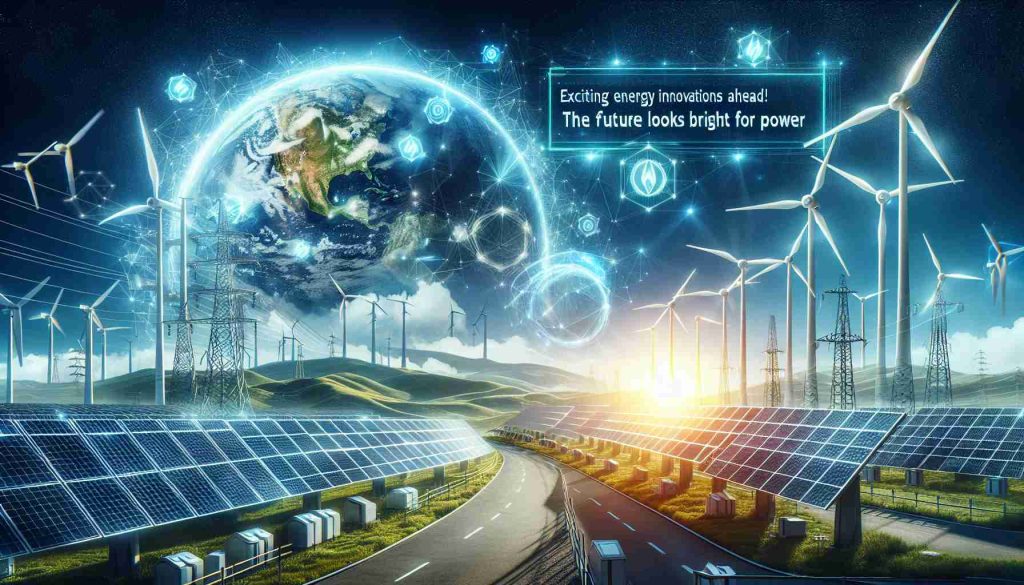Exciting Energy Innovations Ahead! The Future Looks Bright for Power
5 min read
The Energy Landscape of 2025
As 2025 approaches, an urgent demand for enhanced battery storage in vehicles is reshaping our energy landscape. This evolution is giving rise to four significant trends that are set to transform the energy sector.
Revolutionizing Nuclear Power
Small modular reactors (SMRs) are emerging as a promising alternative to standard nuclear plants. With a generation capacity typically under 300 MW, these reactors are being adopted by tech companies to meet the energy needs of massive data centers. Exciting partnerships have sprung up, including one between Dominion Energy and X-energy, which aims to support Amazon’s data centers with SMRs. Similarly, Microsoft is collaborating with Constellation Energy to revitalize the Three Mile Island reactor for its own energy demands.
Electrifying Infrastructure
The move towards electrified infrastructures, including ports and data centers, is accelerating. The European Union has mandated that all ships connect to land-based power from 2030 onward, leading to substantial upgrades in port electrical systems. This transition aims to mitigate emissions and incorporate renewable energy sources efficiently.
The Energy-Water Connection
Striking a balance between energy generation and water resources has never been more critical. New initiatives seek to examine the interdependence of these two vital resources, revealing unique challenges and opportunities depending on location.
Building Resilient Power Systems
Efforts are underway to enhance the resilience of power systems, transitioning from centralized models to diversified frameworks. This includes the development of higher standards for energy storage and predictive platforms to assess climate impacts on energy supply.
With these trends, the energy sector is on the brink of an exciting transformation.
Implications for Society and the Global Economy
As we stand poised on the brink of 2025, the evolving energy landscape carries profound implications for society, culture, and the global economy. The shift towards renewable and nuclear energy solutions is not just a technical advancement; it reflects a broader societal commitment to sustainability and innovation. As companies invest in small modular reactors, this could foster new job opportunities in engineering, construction, and maintenance, stimulating local economies and supporting a shift toward green jobs.
This transformation is also poised to reshape cultural narratives about energy consumption and environmental responsibility. The integration of electrified infrastructures and stringent emissions standards might foster a public consciousness that prioritizes eco-friendly practices. In a world increasingly aware of climate change, this shift could lead to stronger consumer support for companies committed to sustainable operations.
Moreover, the drive towards improved energy-water resource management reflects a growing acknowledgment of the finite nature of these resources. The interdependence of energy and water could inspire innovative cross-sector collaborations that pave the way for sustainable practices across industries.
In terms of long-term significance, as nations invest in resilient power systems, we might witness a gradual decoupling from fossil fuels, which could stabilize global energy markets and reduce geopolitical tensions over resource scarcity. With the ability to harness renewable energy more effectively, countries could achieve a greater degree of energy independence, further shaping the global economy of the future. As such, the collective movement towards these energy solutions marks not just an industrial shift, but a foundational change that may well define the coming decades.
Unlocking the Future: Key Energy Trends Shaping 2025
The Energy Landscape of 2025
As we approach 2025, the energy sector is experiencing a seismic shift driven by the urgent demand for enhanced battery storage, particularly in the automotive industry. Alongside innovation in nuclear power, electrified infrastructure, the energy-water nexus, and resilient power systems, several new trends are emerging that promise to reshape our approach to energy. Below, we explore these trends alongside notable facts, comparisons, and predictions.
# Innovations in Battery Technology
The demand for battery storage is escalating, driven by the growth of electric vehicles (EVs) and renewable energy sources. New technologies such as solid-state batteries are gaining traction due to their potential for higher energy density and improved safety compared to traditional lithium-ion batteries. Leading companies, including Tesla and QuantumScape, are racing to bring these advanced batteries to market. According to industry analysts, the solid-state battery market is projected to grow exponentially, reaching $1.5 billion by 2030.
# Pros and Cons of Small Modular Reactors (SMRs)
SMRs are positioning themselves as a scalable solution for energy generation, particularly for large data centers. Here are some pros and cons:
Pros:
– Flexible Sizing: SMRs can be adjusted based on demand, allowing for more tailored energy solutions.
– Reduced Footprint: They occupy less physical space compared to traditional reactors, making them suitable for urban settings.
Cons:
– Regulatory Hurdles: Developing and deploying SMRs face significant regulatory and safety approval processes.
– Cost Concerns: While they promise to be more cost-effective in the long run, the current upfront investment can be substantial.
# Electrification of Transportation
The trend of electrifying transportation is not just limited to personal vehicles, but extends to commercial shipping as well. The European Union’s mandate for ships to plug into shore power, starting in 2030, is a significant step toward reducing maritime emissions. Ports across the continent are undergoing significant upgrades to facilitate this switch, incorporating cutting-edge technologies to enhance efficiency and sustainability.
# Insights on Energy-Water Nexus
Innovative studies in the energy-water nexus are highlighting how the availability of water can impact energy production and vice versa. New initiatives aim to integrate water management into energy planning, revealing unique opportunities for resource optimization. For instance, research indicates that renewable energy projects, such as solar and wind farms, can be strategically located to reduce water usage and enhance efficiency.
# Building Resilient Power Systems
The energy landscape is increasingly shifting towards resilience through decentralized power systems. This transition enables more robust responses to extreme weather events and fluctuating energy demands. Innovations such as grid-scale battery storage and microgrids are becoming vital, with predictive analytics now playing a major role in anticipating climate impacts on energy supply.
# Pricing and Market Analysis
The growing urgency for renewable energy solutions and battery storage technologies is influencing market prices. Analysts predict the clean energy market will continue to see investment influx, projected to reach $2 trillion by 2025. This surge will likely result in increased competition, thereby driving down costs for consumers and accelerating technology adoption.
# Future Predictions
Looking forward, experts believe that advancements in battery technology and electrification will significantly enhance energy security and efficiency. The International Energy Agency forecasts that by 2030, nearly 40% of energy will come from renewable sources, making it imperative for industries and governments to adopt forward-thinking strategies to manage this transition smoothly.
With these advancements, the energy sector is not only on the threshold of transformation but is also setting the stage for a sustainable and resilient future. For more insights on these trends and innovations, visit Energy.gov.



